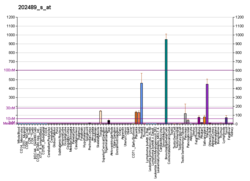FXYD3
FXYD3
Protein-coding gene in the species Homo sapiens
FXYD domain-containing ion transport regulator 3 is a protein that in humans is encoded by the FXYD3 gene.[5][6][7]
| FXYD3 | |||||||||||||||||||||||||||||||
|---|---|---|---|---|---|---|---|---|---|---|---|---|---|---|---|---|---|---|---|---|---|---|---|---|---|---|---|---|---|---|---|
| Identifiers | |||||||||||||||||||||||||||||||
| Aliases | FXYD3, MAT8, PLML, FXYD domain containing ion transport regulator 3 | ||||||||||||||||||||||||||||||
| External IDs | OMIM: 604996; MGI: 107497; HomoloGene: 4356; GeneCards: FXYD3; OMA:FXYD3 - orthologs | ||||||||||||||||||||||||||||||
| |||||||||||||||||||||||||||||||
| |||||||||||||||||||||||||||||||
| |||||||||||||||||||||||||||||||
| |||||||||||||||||||||||||||||||
| Wikidata | |||||||||||||||||||||||||||||||
| |||||||||||||||||||||||||||||||
This gene encodes a member of a family of small membrane proteins that share a 35-amino acid signature sequence domain, beginning with the sequence PFXYD and containing 7 invariant and 6 highly conserved amino acids. The approved human gene nomenclature for the family is FXYD-domain containing ion transport regulator. Mouse FXYD5 has been termed RIC (Related to Ion Channel). FXYD2, also known as the gamma subunit of the Na,K-ATPase, regulates the properties of that enzyme. FXYD1 (phospholemman), FXYD2 (gamma), FXYD3 (MAT-8), FXYD4 (CHIF), and FXYD5 (RIC) have been shown to induce channel activity in experimental expression systems. Transmembrane topology has been established for two family members (FXYD1 and FXYD2), with the N-terminus extracellular and the C-terminus on the cytoplasmic side of the membrane. The protein encoded by this gene may function as a chloride channel or as a chloride channel regulator. Two transcript variants encode two different isoforms of the protein; in addition, transcripts utilizing alternative polyA signals have been described in the literature.[7]
- "Human PubMed Reference:". National Center for Biotechnology Information, U.S. National Library of Medicine.
- "Mouse PubMed Reference:". National Center for Biotechnology Information, U.S. National Library of Medicine.
- Morrison BW, Moorman JR, Kowdley GC, Kobayashi YM, Jones LR, Leder P (Feb 1995). "Mat-8, a novel phospholemman-like protein expressed in human breast tumors, induces a chloride conductance in Xenopus oocytes". The Journal of Biological Chemistry. 270 (5): 2176–82. doi:10.1074/jbc.270.5.2176. PMID 7836447.
- Sweadner KJ, Rael E (Aug 2000). "The FXYD gene family of small ion transport regulators or channels: cDNA sequence, protein signature sequence, and expression". Genomics. 68 (1): 41–56. doi:10.1006/geno.2000.6274. PMID 10950925.
- Crowell KJ, Franzin CM, Koltay A, Lee S, Lucchese AM, Snyder BC, Marassi FM (Jan 2003). "Expression and characterization of the FXYD ion transport regulators for NMR structural studies in lipid micelles and lipid bilayers". Biochimica et Biophysica Acta (BBA) - Proteins and Proteomics. 1645 (1): 15–21. doi:10.1016/S1570-9639(02)00473-9. PMC 2917601. PMID 12535606.
- Grzmil M, Voigt S, Thelen P, Hemmerlein B, Helmke K, Burfeind P (Jan 2004). "Up-regulated expression of the MAT-8 gene in prostate cancer and its siRNA-mediated inhibition of expression induces a decrease in proliferation of human prostate carcinoma cells". International Journal of Oncology. 24 (1): 97–105. doi:10.3892/ijo.24.1.97. PMID 14654946.
- Kayed H, Kleeff J, Kolb A, Ketterer K, Keleg S, Felix K, Giese T, Penzel R, Zentgraf H, Büchler MW, Korc M, Friess H (Jan 2006). "FXYD3 is overexpressed in pancreatic ductal adenocarcinoma and influences pancreatic cancer cell growth". International Journal of Cancer. 118 (1): 43–54. doi:10.1002/ijc.21257. PMID 16003754. S2CID 8644783.
- Franzin CM, Yu J, Thai K, Choi J, Marassi FM (Dec 2005). "Correlation of gene and protein structures in the FXYD family proteins". Journal of Molecular Biology. 354 (4): 743–50. doi:10.1016/j.jmb.2005.10.018. PMC 2907130. PMID 16288923.
- Bibert S, Roy S, Schaer D, Felley-Bosco E, Geering K (Dec 2006). "Structural and functional properties of two human FXYD3 (Mat-8) isoforms". The Journal of Biological Chemistry. 281 (51): 39142–51. doi:10.1074/jbc.M605221200. PMID 17077088.
- Arimochi J, Ohashi-Kobayashi A, Maeda M (Apr 2007). "Interaction of Mat-8 (FXYD-3) with Na+/K+-ATPase in colorectal cancer cells". Biological & Pharmaceutical Bulletin. 30 (4): 648–54. doi:10.1248/bpb.30.648. PMID 17409496.
This article on a gene on human chromosome 19 is a stub. You can help Wikipedia by expanding it. |





